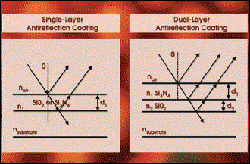Phillip Espinasse
Dr. Steven Kosier
With the emergence of the Blu-ray video recording format, end users can record, rewrite and play back at least two hours of digital HDTV or more than 13 hours of standard video on a single optical disc. Currently, however, Blu-ray systems are found only in the homes of HDTV enthusiasts. Costs must come down before the broad market will accept the format.
One way for manufacturers to control costs is to incorporate as many functions onto as few CMOS or bipolar CMOS chips as possible. In CD/DVD systems, this is accomplished by integrating the photodiode that senses the data with the amplifier. The silicon-based photodiode integrated circuits, therefore, must feature an antireflection coating that is compatible with planar processing and that still allows minimum reflection loss at the wavelength of operation. Unfortunately, the coating strategy employed for the conventional systems doesn't quite work for the next-generation format.
The Blu-ray format differs from current optical storage media technologies in that it uses a 405-nm laser to read and write data, enabling a higher bit density on the disc. But as with conventional CDs and DVDs -- based on 780- and 650-nm lasers, respectively -- a key component of the design is the optical pickup unit, which features the laser, photodetector, beamsplitters, focusing lens and control circuitry.
An antireflection coating is necessary to ensure that the minimum amount of light is reflected and the maximum amount transmitted at the surface of the detector's photosensitive region. The coating improves the external quantum efficiency of the unit as well as increasing the photodetector's responsivity, which boosts the sensitivity of its integrated circuit.
The problem is that the external quantum efficiency of a PIN photodetector is much lower at 405 nm than at 780 nm because silicon more strongly absorbs the shorter-wavelength light. Consequently, optimizing the antireflection coating layer is all the more critical in the design of next-generation systems.
Coating design and optimization require precise modeling of reflection loss. The process must coordinate parameters such as wavelength of operation, coating materials and indices of refraction, as well as layer thickness. The most cost-effective integration of a PIN photodetector in a CMOS or bipolar CMOS platform uses silicon nitride and silicon dioxide, both of which can be deposited by common chemical vapor deposition processes used in all silicon wafer fabrication facilities.

Although a single-layer antireflection coating (left) works well with the photodetector integrated circuits used in conventional optical disc strategies, technology based on 405-nm lasers requires a dual-layer coating (right).
Coatings can be either single- or dual-layer (see figure). Consisting of either SiO2 or Si3N4, the single-layer antireflection coating works by producing two reflections that interfere destructively with each other. Reflection loss is minimized with l/4 film thickness. Reducing the loss beyond this point requires a coating with a Si3N4 top and a SiO2 bottom layer. With this design, the first reflection is canceled by interference from two weaker reflections, and near-zero reflection losses are possible. Although a single-layer coating may be sufficient at longer wavelengths, for which the quantum efficiency is fairly high, the dual-layer coating is critical for photodetectors operating at 405 nm.
Integration of the photodiode and amplifier offers cost and performance advantages for conventional CD/DVD systems. To extend this advantage to the Blu-ray format, novel integration schemes for the antireflection coating are necessary. In the near-term, 650-nm DVDs and 780-nm CDs will remain in use; thus, photodiode integrated circuits intended for operation at 405 nm will have to be backward-compatible with these systems, even with requirements such as dual-layer antireflection coatings.
In the near future, antireflection coatings and integration schemes optimized for all three wavelengths are expected to be a major focus of the photodetector community serving the optical storage market. New silicon-based materials that are compatible with silicon CMOS processing -- such as spin-on glass oxynitrides, silicon oxynitrides and polyimide thin films -- also could lead to plausible coating solutions.